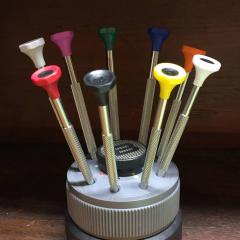Disassembly of ratchet wheel secured with washer
-
Recently Browsing
- No registered users viewing this page.
-
Topics
-
Posts
-
He uses the micrometer cap, but he leaves the spring out (you can see that in the video). If you leave the spring in, the spindle will move up as well (as shown by @Knebo).
-
Seems like he doesn't have the micrometer cap attached to the spindle so he can only push down but cannot pull up? If the cap screws into the spindle I guess you don't need the spring? I only have a "normal" Seitz so I really have no idea.
-
Do you have a part number for the bearing shim lock tool?
-
Yes in my opinion the 3/4HP is plenty but it’s your decision & yes it does come with speed control but foot operation so my reason for changing to potentiometer was because my leg shakes so it was like me revving the lathe & anyway I prefer to set the speed. I & a few others that I recommended the motor to run a Pultra 10mm lathe so if you have a 6 or 8mm B & L then it will be plenty, if you have seen any of my videos you will have seen that when using a graver I run quite slow without any problems. Dell
-









Recommended Posts